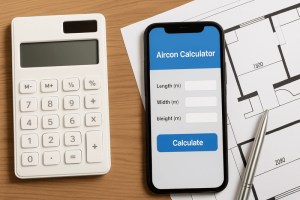Choosing the right air conditioning system isn’t just about picking a unit off the shelf—it’s about ensuring comfort, energy efficiency, and performance tailored to your specific space. Whether you’re cooling a single bedroom or an open-plan living area, selecting the wrong capacity can lead to discomfort, high electricity bills, or an overworked system that fails prematurely.
That’s where an aircon calculator becomes your best friend. Designed to simplify the selection process, it helps homeowners, renters, and business owners find the ideal unit size based on their room dimensions and unique thermal factors.
In this article, we’ll explore how an aircon calculator works, why proper sizing matters, and how tools like the Select Electrical aircon calculator tool make all the difference.

Why Air Conditioner Sizing Matters
When it comes to cooling (or heating) your space, one size definitely does not fit all. Undersized units will struggle to reach your desired temperature, running constantly and driving up your energy bills. On the flip side, oversized systems can short cycle—turning on and off too quickly—which wastes energy, creates inconsistent temperatures, and places excess stress on the compressor.
Proper sizing ensures:
- Optimal performance and comfort
- Lower operating costs
- Longer lifespan of your unit
- Balanced humidity control
- Reduced environmental impact
These factors become even more important in Australian climates, where temperature extremes are common across regions.
What Is an Aircon Calculator?
An aircon calculator is an online tool that estimates the capacity (in kilowatts or kW) of air conditioning required to cool or heat a specific area. It uses inputs such as:
- Room size (length, width, height)
- Insulation level
- Number and size of windows
- Number of occupants
- Appliance heat load (e.g. ovens, computers)
- Room orientation (north-facing rooms receive more sun)
The output typically recommends a range of unit sizes or specific capacities, which can then be matched to real-world products.
Using a tool like the Aircon Calculator – Select Electrical removes the guesswork and empowers you to make confident purchasing decisions—no maths degree required.
How to Use an Aircon Calculator Effectively
Here’s a step-by-step guide on getting the most accurate results from an aircon sizing calculator:
1. Measure the Room
Start by recording the length, width, and ceiling height of the space. For irregular-shaped rooms, break the space into rectangles and calculate each section.
2. Assess Window Areas
Note the number of windows, their orientation (north/south/east/west), and whether they’re shaded or exposed. Direct sunlight can significantly increase cooling load.
3. Consider Room Usage
Is the room a bedroom used overnight, a kitchen with high heat output, or a shared space like a lounge? The function of the room changes its cooling needs.
4. Note Occupancy and Appliances
More people equals more heat. Likewise, electronic devices and lighting can add extra thermal load.
Once these variables are entered into the calculator, you’ll receive a suggested system size in kW. From there, you can speak to an installer or browse suitable units in your price range.
Common Mistakes When Choosing Aircon Units
Even with access to digital tools, some common errors still occur. Here are a few things to watch out for:
- Guessing instead of measuring: Eyeballing room size leads to incorrect capacity estimates.
- Ignoring insulation: Poorly insulated spaces require more power to maintain temperature.
- Choosing based on budget only: A cheap unit may cost more in electricity and maintenance over time.
- Disregarding future renovations: If you’re planning to remove walls or expand a space, account for that in your sizing.
- Overcompensating: Bigger is not always better. Oversized systems are noisy, inefficient, and expensive.
A properly selected system ensures comfort without overburdening your wallet or the environment.
For more details on air conditioning systems and their efficiency performance, explore Smart Home Cooling Strategies or Energy-Efficient Renovation Tips on Hashnode.
The Benefits of Using a Localised Tool
What sets a locally tailored tool apart is its understanding of Australian conditions. The Select Electrical aircon calculator tool is designed with these regional nuances in mind:
- Seasonal humidity and temperature variances
- Common home building materials and insulation levels
- Typical ceiling heights in older vs. newer homes
- Appliance and energy usage patterns in Australian households
It’s also backed by local expertise—if you’re unsure about the result, the team behind the calculator is available to assist with personalised advice.
When to Seek Professional Support
While online tools are incredibly helpful, some situations call for hands-on expertise:
- Multi-room systems or ducted setups
- Unusual architectural layouts (e.g. split-level or lofts)
- Commercial spaces with unique load demands
- Heritage buildings with non-standard insulation or airflow
In such cases, a licensed technician can conduct a Manual J load calculation (the industry gold standard) and advise on zoning, ductwork, and system placement for maximum efficiency.
FAQs About Aircon Sizing and Calculators
Q: How accurate is an aircon calculator?
A: When used correctly with accurate inputs, it provides a very reliable estimate. However, on-site assessments may still be required for complex installations.
Q: What if the calculator recommends a range?
A: Go toward the higher end if the room has poor insulation or high sun exposure, and toward the lower end if it’s shaded and well-sealed.
Q: Does ceiling height really matter?
A: Yes. Rooms with higher ceilings hold more air volume, which affects how much energy is needed to cool the space.
Q: Can I use the same calculator for heating requirements?
A: Many calculators estimate both cooling and heating loads. Just ensure the tool you use provides dual recommendations or ask your installer for a heating-specific analysis.
Final Thoughts
Choosing the right air conditioner isn’t about guessing or hoping for the best—it’s about making informed choices backed by tools that understand your needs. An aircon calculator is a simple, accessible way to do just that.
With tools like the Select Electrical aircon calculator tool, homeowners and business operators can confidently select systems that balance comfort, cost, and efficiency. Whether you’re fitting out a brand-new home or upgrading a rental, it’s the smartest first step you can take toward better climate control.

Leave a Reply